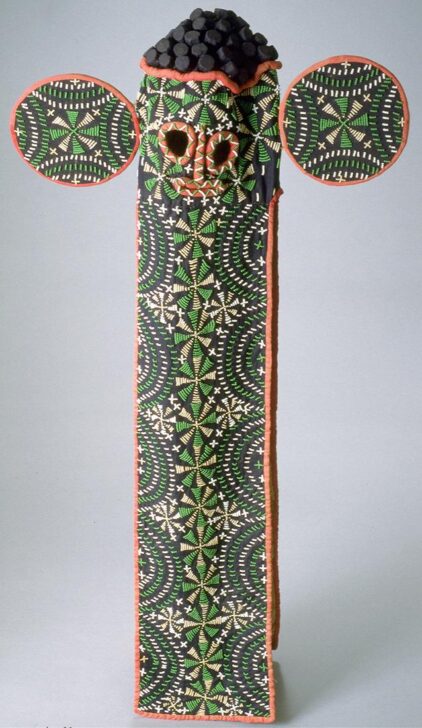Elephant Mask
Bamileke

Description
March 28, 2009
Stylized images of the elephant abound in the pageantry surrounding Bamileke kings and other high-ranking men. Among the most dramatic was the elephant masquerade, which featured masks lavishly embroidered with imported glass beads. Loping like elephants to the accompaniment of drums and gongs, dancers paraded around the palace marketplace, carrying flywhisks and wearing their distinctive regalia.
This mask, with its untraditional green color scheme and imported damask lining, was probably made for the market. However, in African eyes, innovative, market-driven production need not compromise an object’s value or authenticity. Indeed, this mask could have been sold to Bamileke buyers for use in performance.
Subject Matter:
The Kuosi society, previously for warriors, is open to titled men and those who can afford to purchase entry. Member dance at funerals, state occasions, and society meetings. The elephant masks danced by members are called mbap nteng, mbap mteng or tukum, while the society and masks are called aka by western Bamileke peoples. While the elephant no longer inhabits the Grassfields region of Cameroon, it is still a powerful symbol of the king. Elephant masks, with human facial features, large ears, and a long trunk have been called “things of money”, as the beads and cowrie shells used to decorate the masks were used as currency prior to German colonization. Many of the patterns found on the masks are geometric. Some prominently feature isosceles triangles, which have been interpreted as leopard spots. The leopard, like the elephant, is associated with royal power and authority.
References:
Homberger, L. 2008. Cameroon: Art and Kings. Zürich: Museum Rietberg.
Northern, Tamara. 1984. The Art of Cameroon. Washington, D.C.: Smithsonian Institution.
Page, Donna. 2007. A Cameroon World: Art and Artifacts from the Caroline and Marshall Mount Collection. New York: QCC Art Gallery Press.
Physical Description:
This is a face mask embroidered extensively wtih glass beads. Two long panels hang down the front and back of the wearer. The humanoid face at top has two round eye holes allowing the wearer to see, a strip of fabric for a nose, and an open, upturned mouth. Ears are protruding disks attached on either side of the face . The top of the head is covered with small, corklike knobs covered with black cloth. The beadwork is predominantly green with intricate, scallop-shaped patterns along edge of the panels; vertical, star-like patterns fill the center of the panels. The interior of panels is lined with damask.
Usage Rights:
If you are interested in using an image for a publication, please visit https://umma.umich.edu/request-image/ for more information and to fill out the online Image Rights and Reproductions Request Form.